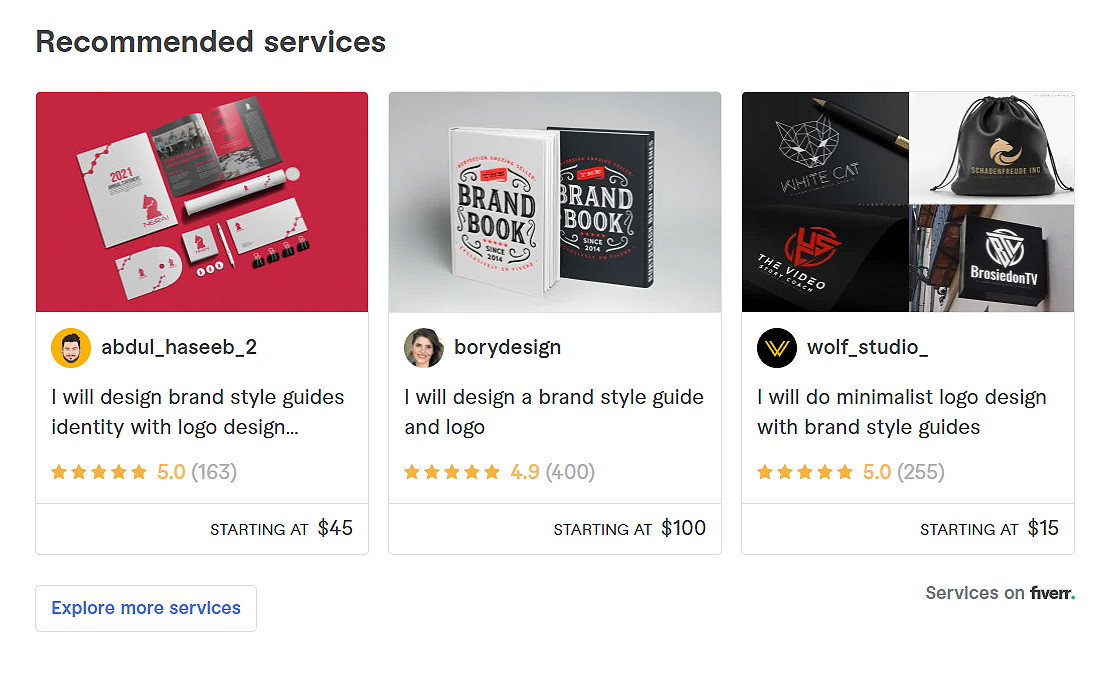Advantages Of Brand Style Guide October USA? | Checkout Best Brand Style Guides on Fiverr 2023
Best Brand Style Guide On Fiverr | Upto 30% OFF Checkout NOW
A brand style guide serves as a compass, steering a company’s visual and messaging elements in the right direction. So let us read more about the Advantages Of Brand Style Guide October USA
So What are the Advantages Of Brand Style Guide October USA?
In today’s digital landscape, establishing a strong online presence is crucial for businesses to thrive. Search Engine Optimization (SEO) plays a pivotal role in ensuring that a brand’s message reaches its intended audience effectively.
One often underestimated tool that can significantly impact SEO success is a Brand Style Guide. This comprehensive document serves as a roadmap to maintain consistency, enhance brand identity, and drive superior SEO performance.
In this Advantages Of Brand Style Guide October USA article, we will delve into the numerous advantages of a Brand Style Guide and how it can propel your brand’s SEO endeavors to new heights.
Consistency Breeds Trust and Credibility
A well-crafted Brand Style Guide is the cornerstone of consistency across all digital platforms. Consistency in visual elements, such as logos, color schemes, fonts, and imagery, instills trust and credibility in the minds of consumers.
So as per this Advantages Of Brand Style Guide October USA artixle, Search engines value user experience, and when a brand delivers a consistent and cohesive identity, it leads to longer visitor dwell times, reduced bounce rates, and ultimately, a positive impact on SEO rankings.
Enhanced User Experience
User experience is a key factor in search engine algorithms. A Brand Style Guide ensures that every piece of content, from website pages to social media posts, is designed with user-centric principles in mind.
So as guided in this Advantages Of Brand Style Guide October USA article, Consistency in design, layout, and content structure enhances user navigation and engagement, which in turn contributes to improved SEO rankings. A seamless user experience translates to increased time spent on the website, higher click-through rates, and better conversion rates.
Optimized Content Creation
A Brand Style Guide serves as a playbook for content creation. By defining guidelines for tone, voice, and messaging, the guide ensures that all content produced aligns with the brand’s values and goals.
SO based on this Advantages Of Brand Style Guide October USA article, When content reflects a consistent brand identity, it becomes easier to integrate relevant keywords seamlessly.
Effective keyword integration is essential for on-page SEO optimization, allowing search engines to better understand the context of your content and improve your chances of ranking higher in search results.
Boosting Brand Recognition
Establishing a strong brand presence is a vital aspect of SEO success. A well-defined Brand Style Guide helps create a unique and memorable brand identity that stands out in a crowded digital landscape.
As users repeatedly encounter consistent branding elements, they become more likely to recognize and recall the brand. Increased brand recognition leads to higher click-through rates in search results, which can indirectly influence search engine rankings.
Efficient Collaboration and Communication
So according to this Advantages Of Brand Style Guide October USA article, In a collaborative digital environment, maintaining a cohesive brand identity can be challenging. A Brand Style Guide acts as a central resource that ensures all team members, from designers to content creators, are on the same page.
Clear guidelines on design specifications, content formatting, and branding elements facilitate efficient collaboration, resulting in content that adheres to the brand’s identity and SEO goals.
Mobile-Friendly Design and Responsiveness
With the growing prevalence of mobile devices, mobile-friendliness has become a crucial factor in SEO ranking algorithms. A well-structured Brand Style Guide encourages the creation of responsive and mobile-friendly design elements.
So considering this Advantages Of Brand Style Guide October USA article, By optimizing visual assets and layouts for various screen sizes, a brand can provide a seamless experience across devices, leading to improved user engagement and ultimately boosting SEO performance.
Structured Data Implementation
Structured data markup enhances the search engine’s understanding of your website’s content, enabling the display of rich snippets in search results.
A Brand Style Guide can include guidelines for implementing structured data, such as schema markup, which can lead to improved visibility and higher click-through rates. This, in turn, positively impacts SEO performance by increasing the likelihood of capturing featured snippets or other enhanced search result features.
Consolidating Brand Authority
Search engines prioritize authoritative and reputable sources. A consistent brand identity established through a Brand Style Guide reinforces the brand’s authority in its industry.
When users perceive a brand as an expert, they are more likely to engage with its content and share it across digital platforms. These user interactions, such as social shares and backlinks, contribute to improved SEO rankings and visibility.
Adaptability to Algorithm Changes
Search engine algorithms are constantly evolving, and what works today might not yield the same results tomorrow. However, a well-structured Brand Style Guide provides a stable foundation that can adapt to algorithmic shifts.
By focusing on fundamental design and branding principles, the guide ensures that the brand’s identity remains intact even as SEO strategies evolve.
Topics To Be Included In Brand Style Guide
A Brand Style Guide is a comprehensive document that outlines the guidelines and standards for the consistent use of your brand’s visual and verbal elements across various mediums. Here are some essential topics to include in your Brand Style Guide:
Brand Overview and Mission:
- Brief introduction to your brand’s history, values, and mission.
- Explanation of the brand’s unique selling proposition (USP) and positioning in the market.
Logo Usage:
- Clear specifications for logo usage, including size, spacing, and minimum size.
- Guidelines for logo placement on different backgrounds and materials.
- Rules for logo color variations (full color, grayscale, monochrome).
Typography:
- List of approved fonts for headings, subheadings, body text, and any other typographic elements.
- Font sizes, line heights, and letter spacing guidelines.
- Recommendations for web and print typography.
Color Palette:
- Detailed color codes (CMYK, RGB, HEX) for the primary and secondary brand colors.
- Usage of colors in various contexts (backgrounds, text, accents).
- Guidelines for maintaining color consistency across different mediums.
Imagery and Photography:
- Preferred image style, such as tone, mood, and subject matter.
- Instructions for image sourcing and guidelines for using stock photos or custom photography.
- Guidance on image treatments (filters, effects, overlays) if applicable.
Graphic Elements:
- Consistent use of shapes, icons, patterns, or other graphic elements.
- Instructions for sizing, placement, and color of graphic elements.
- Guidelines for creating new graphics that align with the brand’s visual identity.
Layout and Design:
- Grid systems, margins, and alignment principles for print and digital materials.
- Templates for commonly used collateral (business cards, letterheads, social media graphics).
- Examples of effective design compositions that represent the brand.
Voice and Tone:
- Description of the brand’s voice and tone (formal, casual, friendly, professional, etc.).
- Writing guidelines for different communication channels (website, social media, marketing materials).
- Sample copy for various scenarios to illustrate the desired tone.
Messaging and Copywriting:
- Taglines, slogans, and brand messages.
- Guidelines for creating compelling headlines and body copy.
- Instructions for writing product descriptions, calls to action, and other promotional content.
Social Media Guidelines:
- Best practices for representing the brand on social media platforms.
- Examples of post types, language, and visual content that align with the brand.
Web Design Guidelines:
- Recommendations for website layout, navigation, and user experience.
- Guidelines for creating consistent web elements (buttons, forms, headers, footers).
Print and Packaging Guidelines:
- Instructions for maintaining brand consistency on physical materials (brochures, packaging, signage).
- Specifications for print quality, paper types, and finishes.
Use Cases and Examples:
- Real-world examples showcasing the brand’s identity applied to different mediums.
- Before-and-after comparisons demonstrating proper vs. improper usage.
Legal and Trademark Information:
- Guidelines for proper trademark usage and copyright information.
- Any legal disclaimers or usage restrictions related to the brand elements.
Contact Information:
Contact details for the brand’s creative or marketing team responsible for enforcing the style guide.
Remember, the goal of a Brand Style Guide is to ensure consistency and cohesion across all brand communications. Customize these topics based on your brand’s specific needs and the mediums you plan to use.
Conclusion About Advantages Of Brand Style Guide October USA
In the ever-evolving landscape of digital marketing, a Brand Style Guide stands as a potent tool for enhancing SEO performance.
The advantages it offers, including consistency, enhanced user experience, optimized content creation, and improved brand recognition, make it an indispensable asset for any business seeking to establish a formidable online presence.
By investing in a comprehensive Brand Style Guide, businesses can unlock the full potential of their brand’s identity and drive SEO success to new heights. So this concludes the article about Advantages Of Brand Style Guide October USA.

